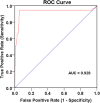Computational MHC-I epitope predictor identifies 95% of experimentally mapped HIV-1 clade A and D epitopes in a Ugandan cohort
- PMID: 32087680
- PMCID: PMC7036183
- DOI: 10.1186/s12879-020-4876-4
Computational MHC-I epitope predictor identifies 95% of experimentally mapped HIV-1 clade A and D epitopes in a Ugandan cohort
Abstract
Background: Identifying immunogens that induce HIV-1-specific immune responses is a lengthy process that can benefit from computational methods, which predict T-cell epitopes for various HLA types.
Methods: We tested the performance of the NetMHCpan4.0 computational neural network in re-identifying 93 T-cell epitopes that had been previously independently mapped using the whole proteome IFN-γ ELISPOT assays in 6 HLA class I typed Ugandan individuals infected with HIV-1 subtypes A1 and D. To provide a benchmark we compared the predictions for NetMHCpan4.0 to MHCflurry1.2.0 and NetCTL1.2.
Results: NetMHCpan4.0 performed best correctly predicting 88 of the 93 experimentally mapped epitopes for a set length of 9-mer and matched HLA class I alleles. Receiver Operator Characteristic (ROC) analysis gave an area under the curve (AUC) of 0.928. Setting NetMHCpan4.0 to predict 11-14mer length did not improve the prediction (37-79 of 93 peptides) with an inverse correlation between the number of predictions and length set. Late time point peptides were significantly stronger binders than early peptides (Wilcoxon signed rank test: p = 0.0000005). MHCflurry1.2.0 similarly predicted all but 2 of the peptides that NetMHCpan4.0 predicted and NetCTL1.2 predicted only 14 of the 93 experimental peptides.
Conclusion: NetMHCpan4.0 class I epitope predictions covered 95% of the epitope responses identified in six HIV-1 infected individuals, and would have reduced the number of experimental confirmatory tests by > 80%. Algorithmic epitope prediction in conjunction with HLA allele frequency information can cost-effectively assist immunogen design through minimizing the experimental effort.
Keywords: Artificial neural network; Epitope mapping; HIV-1; In-silico; MHCflurry1.2.0 and NetCTL1.2; NetMHCpan4.0.; T-cell.
Conflict of interest statement
The authors declare that they have no competing interests.
Figures





Similar articles
-
Comparison of experimental fine-mapping to in silico prediction results of HIV-1 epitopes reveals ongoing need for mapping experiments.Immunology. 2014 Oct;143(2):193-201. doi: 10.1111/imm.12301. Immunology. 2014. PMID: 24724694 Free PMC article.
-
Presentation of available CTL epitopes that induction of cell-mediated immune response against HIV-1 Koran clade B strain using computational technology.HIV Med. 2016 Jun;17(6):460-6. doi: 10.1111/hiv.12316. Epub 2015 Oct 15. HIV Med. 2016. PMID: 26471354
-
Development of a novel in silico docking simulation model for the fine HIV-1 cytotoxic T lymphocyte epitope mapping.PLoS One. 2012;7(7):e41703. doi: 10.1371/journal.pone.0041703. Epub 2012 Jul 27. PLoS One. 2012. PMID: 22848572 Free PMC article.
-
Enhanced Recognition of HIV-1 Cryptic Epitopes Restricted by HLA Class I Alleles Associated With a Favorable Clinical Outcome.J Acquir Immune Defic Syndr. 2015 Sep 1;70(1):1-8. doi: 10.1097/QAI.0000000000000700. J Acquir Immune Defic Syndr. 2015. PMID: 26322665 Free PMC article.
-
Bioinformatics tools for identifying class I-restricted epitopes.Methods. 2003 Mar;29(3):289-98. doi: 10.1016/s1046-2023(02)00351-1. Methods. 2003. PMID: 12725794 Review.
Cited by
-
Immunoinformatics-guided design of an epitope-based vaccine against severe acute respiratory syndrome coronavirus 2 spike glycoprotein.Comput Biol Med. 2020 Sep;124:103967. doi: 10.1016/j.compbiomed.2020.103967. Epub 2020 Aug 13. Comput Biol Med. 2020. PMID: 32828069 Free PMC article.
-
Identification of a Clade-Specific HLA-C*03:02 CTL Epitope GY9 Derived from the HIV-1 p17 Matrix Protein.Int J Mol Sci. 2024 Sep 6;25(17):9683. doi: 10.3390/ijms25179683. Int J Mol Sci. 2024. PMID: 39273630 Free PMC article.
-
A Conserved Acidic Residue in the C-Terminal Flexible Loop of HIV-1 Nef Contributes to the Activity of SERINC5 and CD4 Downregulation.Viruses. 2023 Feb 28;15(3):652. doi: 10.3390/v15030652. Viruses. 2023. PMID: 36992361 Free PMC article.
-
Large-scale screening of HIV-1 T-cell epitopes restricted by 12 prevalent HLA-A allotypes in Northeast Asia and universal detection of HIV-1-specific CD8+ T cells.Front Microbiol. 2025 Feb 11;16:1529721. doi: 10.3389/fmicb.2025.1529721. eCollection 2025. Front Microbiol. 2025. PMID: 40008047 Free PMC article.
-
A systematic review of T cell epitopes defined from the proteome of human immunodeficiency virus.Virus Res. 2025 Aug;358:199602. doi: 10.1016/j.virusres.2025.199602. Epub 2025 Jun 23. Virus Res. 2025. PMID: 40562176 Free PMC article. Review.
References
-
- Azizi A, Anderson DE, Torres JV, Ogrel A, Ghorbani M, Soare C, Sandstrom P, Fournier J, Diaz-Mitoma F. Induction of broad cross-subtype-specific HIV-1 immune responses by a novel multivalent HIV-1 peptide vaccine in cynomolgus macaques. J Immunol. 2008;180(4):2174–2186. doi: 10.4049/jimmunol.180.4.2174. - DOI - PubMed
-
- Baden LR, Walsh SR, Seaman MS, Cohen YZ, Johnson JA, Licona JH, Filter RD, Kleinjan JA, Gothing JA, Jennings J, et al. First-in-human randomized controlled trial of mosaic HIV-1 Immunogens delivered via a modified Vaccinia Ankara vector. J Infect Dis. 2018;218(4):633–644. doi: 10.1093/infdis/jiy212. - DOI - PMC - PubMed
MeSH terms
Substances
Grants and funding
- MC_UU_00027/1/MRC_/Medical Research Council/United Kingdom
- TA_05_40200_40203/European and Developing Countries Clinical Trials Partnership
- WT078927MA/UK Medical Research Council (MRC) and the UK Department for International Development (DFID) under the MRC/DFID Concordat agreement, the Wellcome Trust
LinkOut - more resources
Full Text Sources
Medical
Research Materials
Miscellaneous

